Essay: Adapting Strategies in a Changing Business Environment
VerifiedAdded on 2021/02/19
|8
|2278
|100
Essay
AI Summary
This essay delves into the critical ability of organizations to adapt their strategies to an ever-changing and volatile business environment. It explores how companies can predict, meet, and gain a competitive advantage through both emergent and planned change initiatives. The essay examines the increasing complexity of the global business context, emphasizing the need for organizations to balance structural, conventional, and prearranged change methods with new approaches. It discusses the importance of effective leadership and management in navigating change, highlighting the role of change management models like Lewin's and McKinsey's 7S. The essay differentiates between planned and emergent change, offering insights into how both can be leveraged to achieve sustainable success in the marketplace. The conclusion reinforces the necessity of change for organizational growth and development, underscoring the role of leadership in aligning firm operations with the evolving business environment.
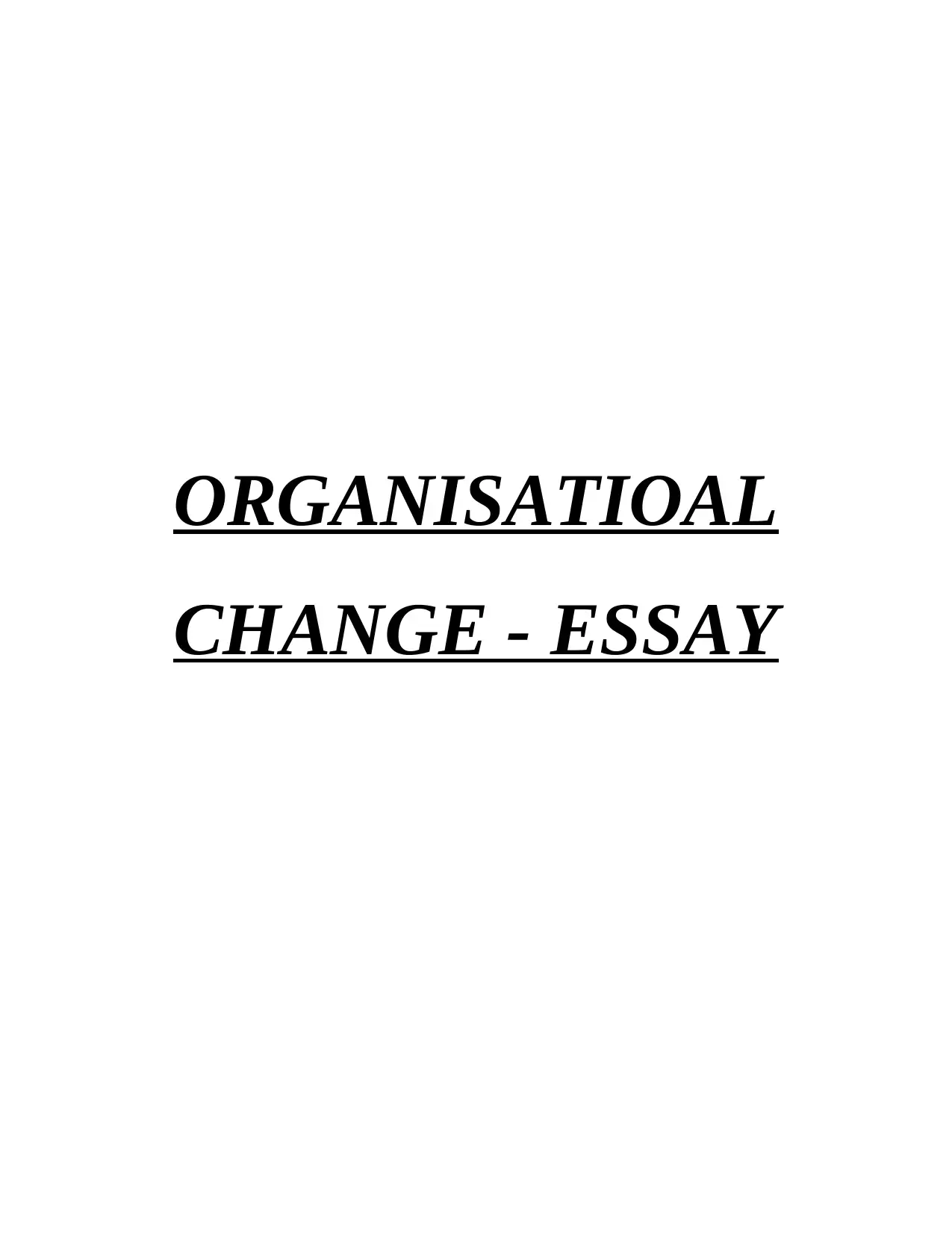
ORGANISATIOAL
CHANGE - ESSAY
CHANGE - ESSAY
Paraphrase This Document
Need a fresh take? Get an instant paraphrase of this document with our AI Paraphraser
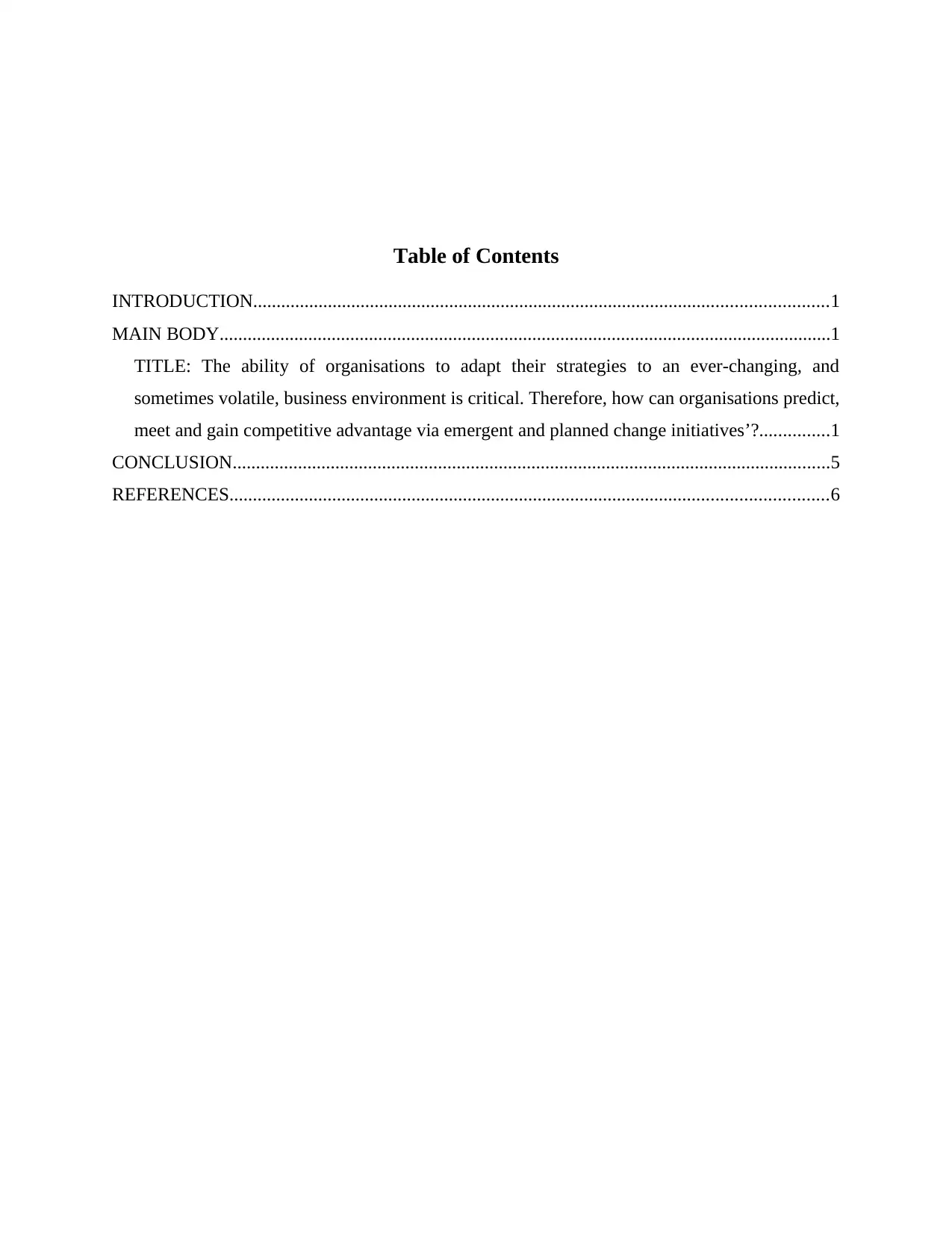
Table of Contents
INTRODUCTION...........................................................................................................................1
MAIN BODY...................................................................................................................................1
TITLE: The ability of organisations to adapt their strategies to an ever-changing, and
sometimes volatile, business environment is critical. Therefore, how can organisations predict,
meet and gain competitive advantage via emergent and planned change initiatives’?...............1
CONCLUSION................................................................................................................................5
REFERENCES................................................................................................................................6
INTRODUCTION...........................................................................................................................1
MAIN BODY...................................................................................................................................1
TITLE: The ability of organisations to adapt their strategies to an ever-changing, and
sometimes volatile, business environment is critical. Therefore, how can organisations predict,
meet and gain competitive advantage via emergent and planned change initiatives’?...............1
CONCLUSION................................................................................................................................5
REFERENCES................................................................................................................................6
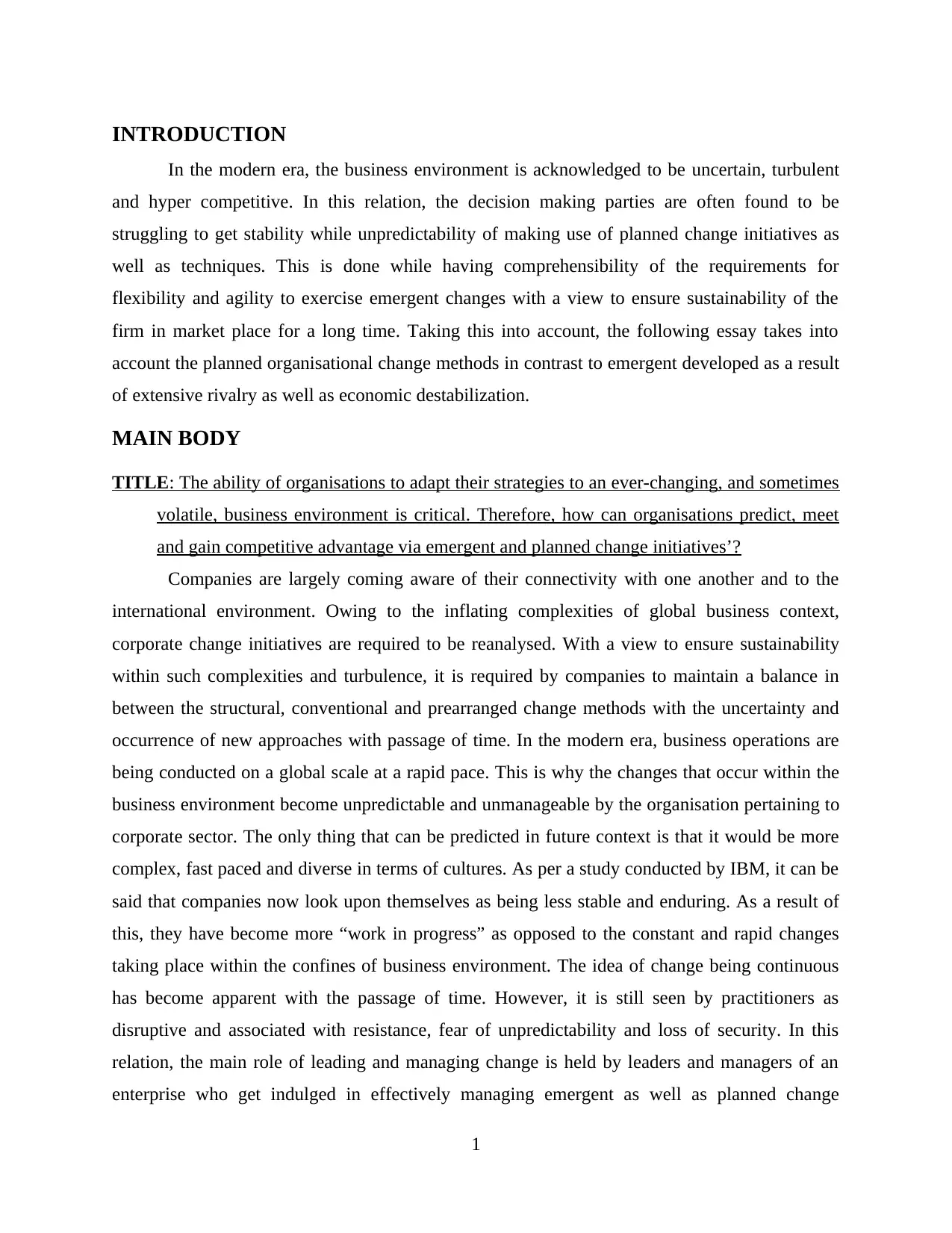
INTRODUCTION
In the modern era, the business environment is acknowledged to be uncertain, turbulent
and hyper competitive. In this relation, the decision making parties are often found to be
struggling to get stability while unpredictability of making use of planned change initiatives as
well as techniques. This is done while having comprehensibility of the requirements for
flexibility and agility to exercise emergent changes with a view to ensure sustainability of the
firm in market place for a long time. Taking this into account, the following essay takes into
account the planned organisational change methods in contrast to emergent developed as a result
of extensive rivalry as well as economic destabilization.
MAIN BODY
TITLE: The ability of organisations to adapt their strategies to an ever-changing, and sometimes
volatile, business environment is critical. Therefore, how can organisations predict, meet
and gain competitive advantage via emergent and planned change initiatives’?
Companies are largely coming aware of their connectivity with one another and to the
international environment. Owing to the inflating complexities of global business context,
corporate change initiatives are required to be reanalysed. With a view to ensure sustainability
within such complexities and turbulence, it is required by companies to maintain a balance in
between the structural, conventional and prearranged change methods with the uncertainty and
occurrence of new approaches with passage of time. In the modern era, business operations are
being conducted on a global scale at a rapid pace. This is why the changes that occur within the
business environment become unpredictable and unmanageable by the organisation pertaining to
corporate sector. The only thing that can be predicted in future context is that it would be more
complex, fast paced and diverse in terms of cultures. As per a study conducted by IBM, it can be
said that companies now look upon themselves as being less stable and enduring. As a result of
this, they have become more “work in progress” as opposed to the constant and rapid changes
taking place within the confines of business environment. The idea of change being continuous
has become apparent with the passage of time. However, it is still seen by practitioners as
disruptive and associated with resistance, fear of unpredictability and loss of security. In this
relation, the main role of leading and managing change is held by leaders and managers of an
enterprise who get indulged in effectively managing emergent as well as planned change
1
In the modern era, the business environment is acknowledged to be uncertain, turbulent
and hyper competitive. In this relation, the decision making parties are often found to be
struggling to get stability while unpredictability of making use of planned change initiatives as
well as techniques. This is done while having comprehensibility of the requirements for
flexibility and agility to exercise emergent changes with a view to ensure sustainability of the
firm in market place for a long time. Taking this into account, the following essay takes into
account the planned organisational change methods in contrast to emergent developed as a result
of extensive rivalry as well as economic destabilization.
MAIN BODY
TITLE: The ability of organisations to adapt their strategies to an ever-changing, and sometimes
volatile, business environment is critical. Therefore, how can organisations predict, meet
and gain competitive advantage via emergent and planned change initiatives’?
Companies are largely coming aware of their connectivity with one another and to the
international environment. Owing to the inflating complexities of global business context,
corporate change initiatives are required to be reanalysed. With a view to ensure sustainability
within such complexities and turbulence, it is required by companies to maintain a balance in
between the structural, conventional and prearranged change methods with the uncertainty and
occurrence of new approaches with passage of time. In the modern era, business operations are
being conducted on a global scale at a rapid pace. This is why the changes that occur within the
business environment become unpredictable and unmanageable by the organisation pertaining to
corporate sector. The only thing that can be predicted in future context is that it would be more
complex, fast paced and diverse in terms of cultures. As per a study conducted by IBM, it can be
said that companies now look upon themselves as being less stable and enduring. As a result of
this, they have become more “work in progress” as opposed to the constant and rapid changes
taking place within the confines of business environment. The idea of change being continuous
has become apparent with the passage of time. However, it is still seen by practitioners as
disruptive and associated with resistance, fear of unpredictability and loss of security. In this
relation, the main role of leading and managing change is held by leaders and managers of an
enterprise who get indulged in effectively managing emergent as well as planned change
1
⊘ This is a preview!⊘
Do you want full access?
Subscribe today to unlock all pages.

Trusted by 1+ million students worldwide
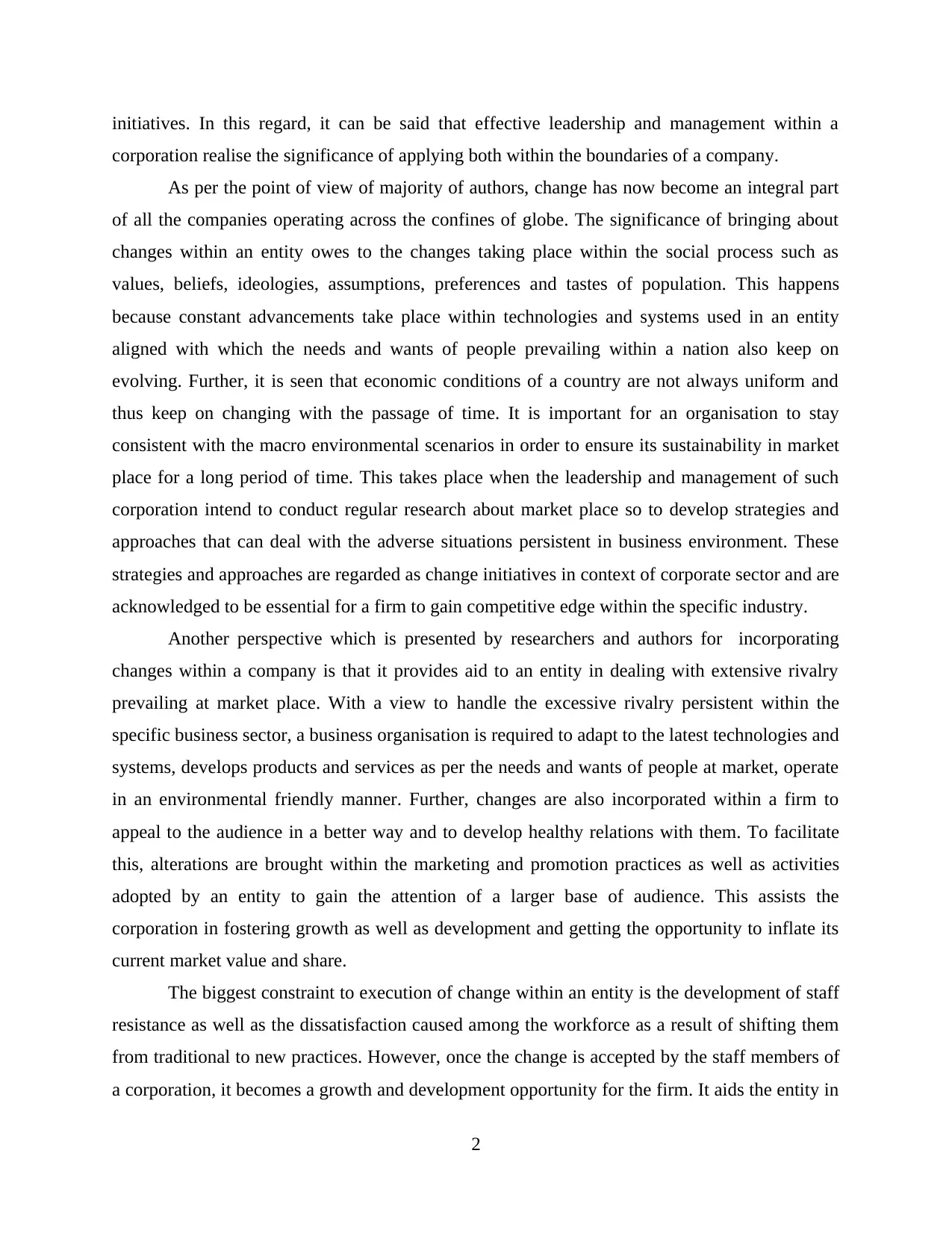
initiatives. In this regard, it can be said that effective leadership and management within a
corporation realise the significance of applying both within the boundaries of a company.
As per the point of view of majority of authors, change has now become an integral part
of all the companies operating across the confines of globe. The significance of bringing about
changes within an entity owes to the changes taking place within the social process such as
values, beliefs, ideologies, assumptions, preferences and tastes of population. This happens
because constant advancements take place within technologies and systems used in an entity
aligned with which the needs and wants of people prevailing within a nation also keep on
evolving. Further, it is seen that economic conditions of a country are not always uniform and
thus keep on changing with the passage of time. It is important for an organisation to stay
consistent with the macro environmental scenarios in order to ensure its sustainability in market
place for a long period of time. This takes place when the leadership and management of such
corporation intend to conduct regular research about market place so to develop strategies and
approaches that can deal with the adverse situations persistent in business environment. These
strategies and approaches are regarded as change initiatives in context of corporate sector and are
acknowledged to be essential for a firm to gain competitive edge within the specific industry.
Another perspective which is presented by researchers and authors for incorporating
changes within a company is that it provides aid to an entity in dealing with extensive rivalry
prevailing at market place. With a view to handle the excessive rivalry persistent within the
specific business sector, a business organisation is required to adapt to the latest technologies and
systems, develops products and services as per the needs and wants of people at market, operate
in an environmental friendly manner. Further, changes are also incorporated within a firm to
appeal to the audience in a better way and to develop healthy relations with them. To facilitate
this, alterations are brought within the marketing and promotion practices as well as activities
adopted by an entity to gain the attention of a larger base of audience. This assists the
corporation in fostering growth as well as development and getting the opportunity to inflate its
current market value and share.
The biggest constraint to execution of change within an entity is the development of staff
resistance as well as the dissatisfaction caused among the workforce as a result of shifting them
from traditional to new practices. However, once the change is accepted by the staff members of
a corporation, it becomes a growth and development opportunity for the firm. It aids the entity in
2
corporation realise the significance of applying both within the boundaries of a company.
As per the point of view of majority of authors, change has now become an integral part
of all the companies operating across the confines of globe. The significance of bringing about
changes within an entity owes to the changes taking place within the social process such as
values, beliefs, ideologies, assumptions, preferences and tastes of population. This happens
because constant advancements take place within technologies and systems used in an entity
aligned with which the needs and wants of people prevailing within a nation also keep on
evolving. Further, it is seen that economic conditions of a country are not always uniform and
thus keep on changing with the passage of time. It is important for an organisation to stay
consistent with the macro environmental scenarios in order to ensure its sustainability in market
place for a long period of time. This takes place when the leadership and management of such
corporation intend to conduct regular research about market place so to develop strategies and
approaches that can deal with the adverse situations persistent in business environment. These
strategies and approaches are regarded as change initiatives in context of corporate sector and are
acknowledged to be essential for a firm to gain competitive edge within the specific industry.
Another perspective which is presented by researchers and authors for incorporating
changes within a company is that it provides aid to an entity in dealing with extensive rivalry
prevailing at market place. With a view to handle the excessive rivalry persistent within the
specific business sector, a business organisation is required to adapt to the latest technologies and
systems, develops products and services as per the needs and wants of people at market, operate
in an environmental friendly manner. Further, changes are also incorporated within a firm to
appeal to the audience in a better way and to develop healthy relations with them. To facilitate
this, alterations are brought within the marketing and promotion practices as well as activities
adopted by an entity to gain the attention of a larger base of audience. This assists the
corporation in fostering growth as well as development and getting the opportunity to inflate its
current market value and share.
The biggest constraint to execution of change within an entity is the development of staff
resistance as well as the dissatisfaction caused among the workforce as a result of shifting them
from traditional to new practices. However, once the change is accepted by the staff members of
a corporation, it becomes a growth and development opportunity for the firm. It aids the entity in
2
Paraphrase This Document
Need a fresh take? Get an instant paraphrase of this document with our AI Paraphraser
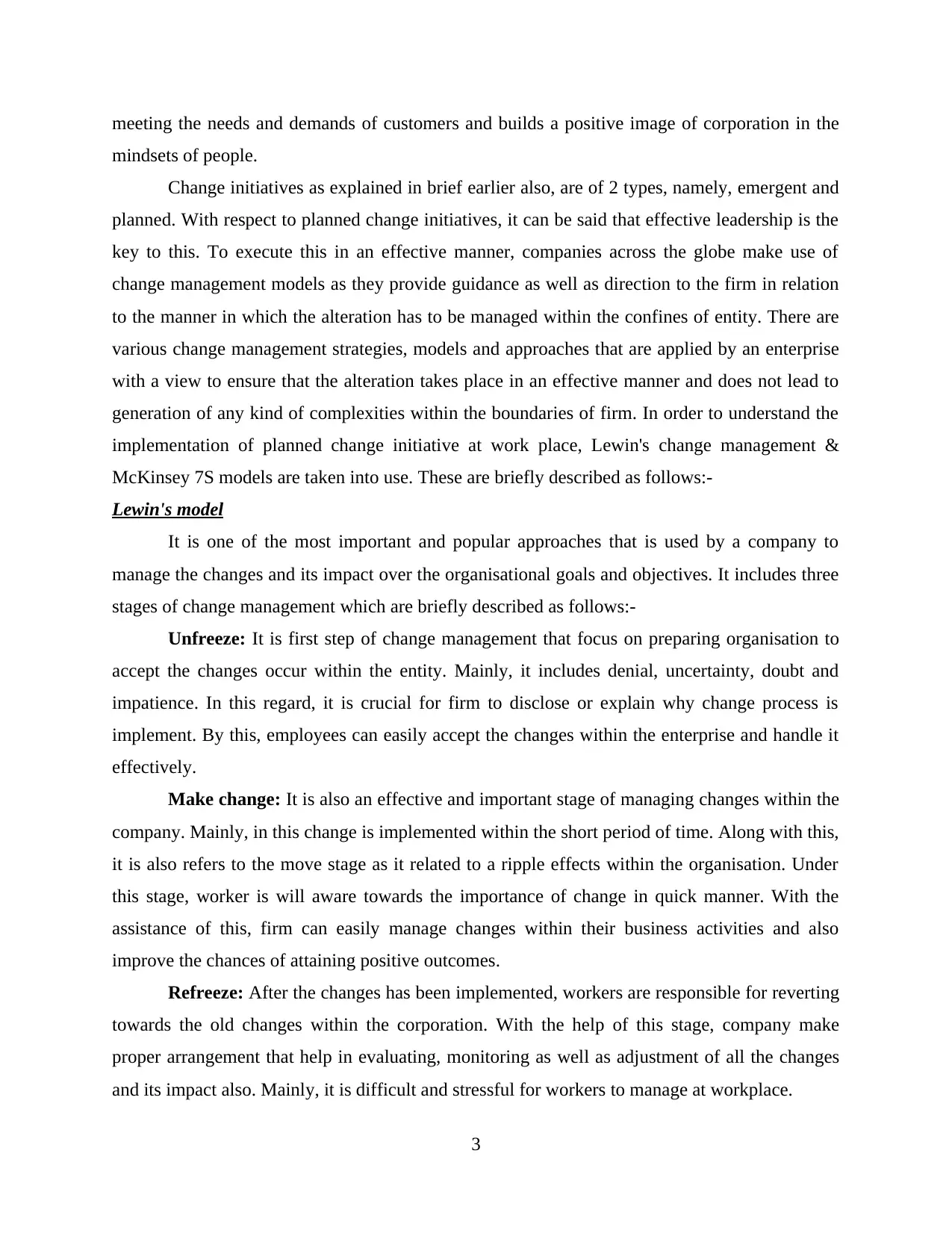
meeting the needs and demands of customers and builds a positive image of corporation in the
mindsets of people.
Change initiatives as explained in brief earlier also, are of 2 types, namely, emergent and
planned. With respect to planned change initiatives, it can be said that effective leadership is the
key to this. To execute this in an effective manner, companies across the globe make use of
change management models as they provide guidance as well as direction to the firm in relation
to the manner in which the alteration has to be managed within the confines of entity. There are
various change management strategies, models and approaches that are applied by an enterprise
with a view to ensure that the alteration takes place in an effective manner and does not lead to
generation of any kind of complexities within the boundaries of firm. In order to understand the
implementation of planned change initiative at work place, Lewin's change management &
McKinsey 7S models are taken into use. These are briefly described as follows:-
Lewin's model
It is one of the most important and popular approaches that is used by a company to
manage the changes and its impact over the organisational goals and objectives. It includes three
stages of change management which are briefly described as follows:-
Unfreeze: It is first step of change management that focus on preparing organisation to
accept the changes occur within the entity. Mainly, it includes denial, uncertainty, doubt and
impatience. In this regard, it is crucial for firm to disclose or explain why change process is
implement. By this, employees can easily accept the changes within the enterprise and handle it
effectively.
Make change: It is also an effective and important stage of managing changes within the
company. Mainly, in this change is implemented within the short period of time. Along with this,
it is also refers to the move stage as it related to a ripple effects within the organisation. Under
this stage, worker is will aware towards the importance of change in quick manner. With the
assistance of this, firm can easily manage changes within their business activities and also
improve the chances of attaining positive outcomes.
Refreeze: After the changes has been implemented, workers are responsible for reverting
towards the old changes within the corporation. With the help of this stage, company make
proper arrangement that help in evaluating, monitoring as well as adjustment of all the changes
and its impact also. Mainly, it is difficult and stressful for workers to manage at workplace.
3
mindsets of people.
Change initiatives as explained in brief earlier also, are of 2 types, namely, emergent and
planned. With respect to planned change initiatives, it can be said that effective leadership is the
key to this. To execute this in an effective manner, companies across the globe make use of
change management models as they provide guidance as well as direction to the firm in relation
to the manner in which the alteration has to be managed within the confines of entity. There are
various change management strategies, models and approaches that are applied by an enterprise
with a view to ensure that the alteration takes place in an effective manner and does not lead to
generation of any kind of complexities within the boundaries of firm. In order to understand the
implementation of planned change initiative at work place, Lewin's change management &
McKinsey 7S models are taken into use. These are briefly described as follows:-
Lewin's model
It is one of the most important and popular approaches that is used by a company to
manage the changes and its impact over the organisational goals and objectives. It includes three
stages of change management which are briefly described as follows:-
Unfreeze: It is first step of change management that focus on preparing organisation to
accept the changes occur within the entity. Mainly, it includes denial, uncertainty, doubt and
impatience. In this regard, it is crucial for firm to disclose or explain why change process is
implement. By this, employees can easily accept the changes within the enterprise and handle it
effectively.
Make change: It is also an effective and important stage of managing changes within the
company. Mainly, in this change is implemented within the short period of time. Along with this,
it is also refers to the move stage as it related to a ripple effects within the organisation. Under
this stage, worker is will aware towards the importance of change in quick manner. With the
assistance of this, firm can easily manage changes within their business activities and also
improve the chances of attaining positive outcomes.
Refreeze: After the changes has been implemented, workers are responsible for reverting
towards the old changes within the corporation. With the help of this stage, company make
proper arrangement that help in evaluating, monitoring as well as adjustment of all the changes
and its impact also. Mainly, it is difficult and stressful for workers to manage at workplace.
3
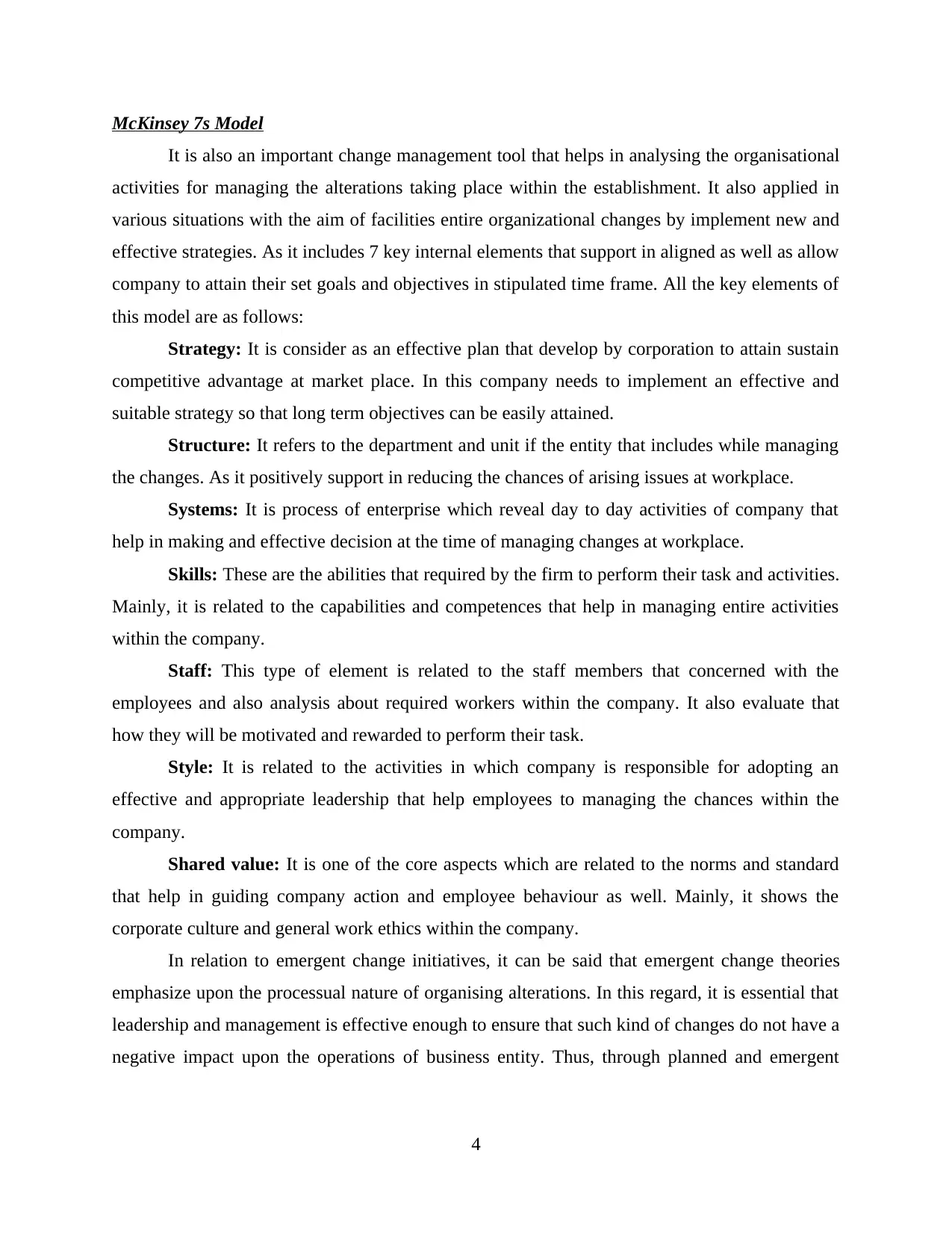
McKinsey 7s Model
It is also an important change management tool that helps in analysing the organisational
activities for managing the alterations taking place within the establishment. It also applied in
various situations with the aim of facilities entire organizational changes by implement new and
effective strategies. As it includes 7 key internal elements that support in aligned as well as allow
company to attain their set goals and objectives in stipulated time frame. All the key elements of
this model are as follows:
Strategy: It is consider as an effective plan that develop by corporation to attain sustain
competitive advantage at market place. In this company needs to implement an effective and
suitable strategy so that long term objectives can be easily attained.
Structure: It refers to the department and unit if the entity that includes while managing
the changes. As it positively support in reducing the chances of arising issues at workplace.
Systems: It is process of enterprise which reveal day to day activities of company that
help in making and effective decision at the time of managing changes at workplace.
Skills: These are the abilities that required by the firm to perform their task and activities.
Mainly, it is related to the capabilities and competences that help in managing entire activities
within the company.
Staff: This type of element is related to the staff members that concerned with the
employees and also analysis about required workers within the company. It also evaluate that
how they will be motivated and rewarded to perform their task.
Style: It is related to the activities in which company is responsible for adopting an
effective and appropriate leadership that help employees to managing the chances within the
company.
Shared value: It is one of the core aspects which are related to the norms and standard
that help in guiding company action and employee behaviour as well. Mainly, it shows the
corporate culture and general work ethics within the company.
In relation to emergent change initiatives, it can be said that emergent change theories
emphasize upon the processual nature of organising alterations. In this regard, it is essential that
leadership and management is effective enough to ensure that such kind of changes do not have a
negative impact upon the operations of business entity. Thus, through planned and emergent
4
It is also an important change management tool that helps in analysing the organisational
activities for managing the alterations taking place within the establishment. It also applied in
various situations with the aim of facilities entire organizational changes by implement new and
effective strategies. As it includes 7 key internal elements that support in aligned as well as allow
company to attain their set goals and objectives in stipulated time frame. All the key elements of
this model are as follows:
Strategy: It is consider as an effective plan that develop by corporation to attain sustain
competitive advantage at market place. In this company needs to implement an effective and
suitable strategy so that long term objectives can be easily attained.
Structure: It refers to the department and unit if the entity that includes while managing
the changes. As it positively support in reducing the chances of arising issues at workplace.
Systems: It is process of enterprise which reveal day to day activities of company that
help in making and effective decision at the time of managing changes at workplace.
Skills: These are the abilities that required by the firm to perform their task and activities.
Mainly, it is related to the capabilities and competences that help in managing entire activities
within the company.
Staff: This type of element is related to the staff members that concerned with the
employees and also analysis about required workers within the company. It also evaluate that
how they will be motivated and rewarded to perform their task.
Style: It is related to the activities in which company is responsible for adopting an
effective and appropriate leadership that help employees to managing the chances within the
company.
Shared value: It is one of the core aspects which are related to the norms and standard
that help in guiding company action and employee behaviour as well. Mainly, it shows the
corporate culture and general work ethics within the company.
In relation to emergent change initiatives, it can be said that emergent change theories
emphasize upon the processual nature of organising alterations. In this regard, it is essential that
leadership and management is effective enough to ensure that such kind of changes do not have a
negative impact upon the operations of business entity. Thus, through planned and emergent
4
⊘ This is a preview!⊘
Do you want full access?
Subscribe today to unlock all pages.

Trusted by 1+ million students worldwide
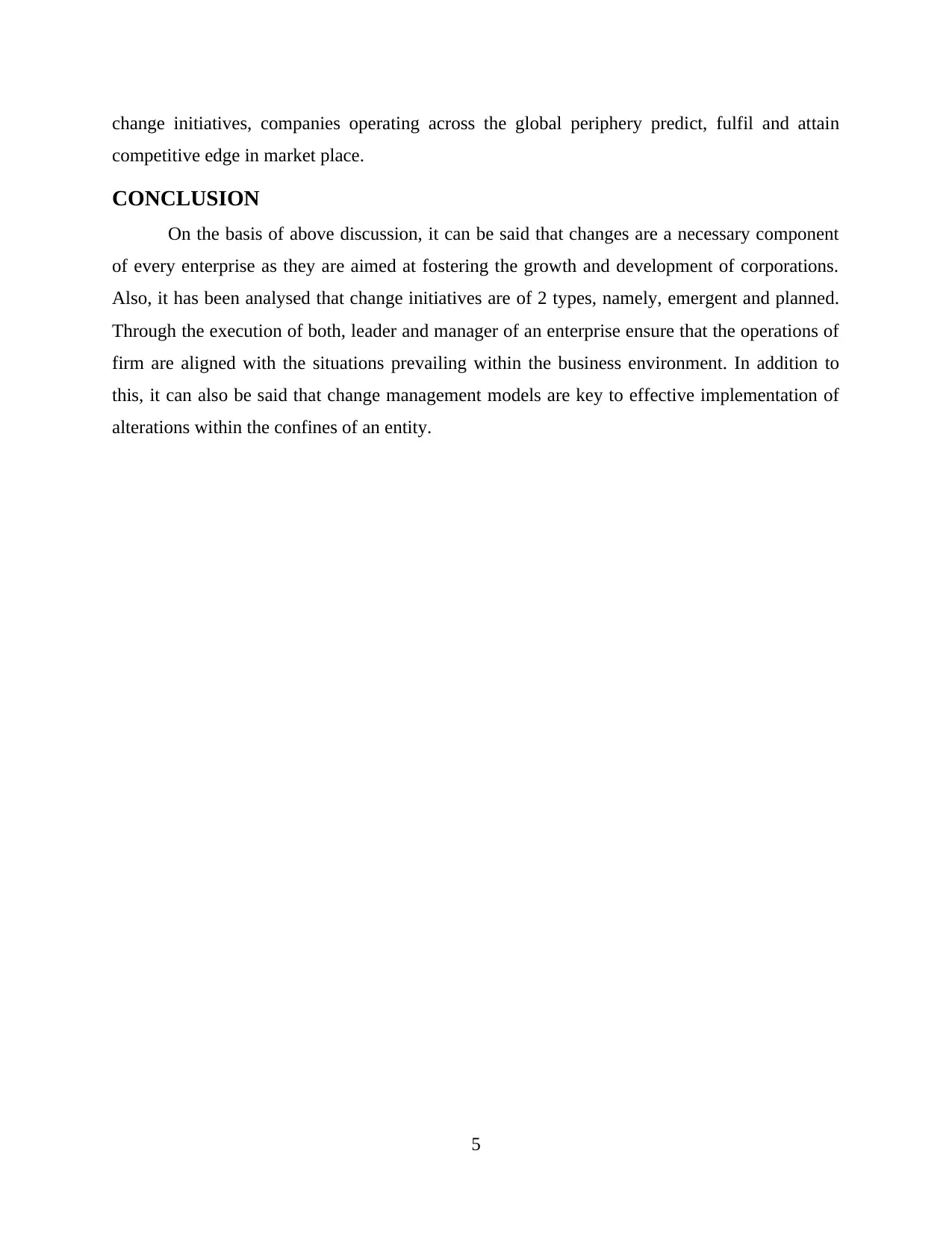
change initiatives, companies operating across the global periphery predict, fulfil and attain
competitive edge in market place.
CONCLUSION
On the basis of above discussion, it can be said that changes are a necessary component
of every enterprise as they are aimed at fostering the growth and development of corporations.
Also, it has been analysed that change initiatives are of 2 types, namely, emergent and planned.
Through the execution of both, leader and manager of an enterprise ensure that the operations of
firm are aligned with the situations prevailing within the business environment. In addition to
this, it can also be said that change management models are key to effective implementation of
alterations within the confines of an entity.
5
competitive edge in market place.
CONCLUSION
On the basis of above discussion, it can be said that changes are a necessary component
of every enterprise as they are aimed at fostering the growth and development of corporations.
Also, it has been analysed that change initiatives are of 2 types, namely, emergent and planned.
Through the execution of both, leader and manager of an enterprise ensure that the operations of
firm are aligned with the situations prevailing within the business environment. In addition to
this, it can also be said that change management models are key to effective implementation of
alterations within the confines of an entity.
5
Paraphrase This Document
Need a fresh take? Get an instant paraphrase of this document with our AI Paraphraser
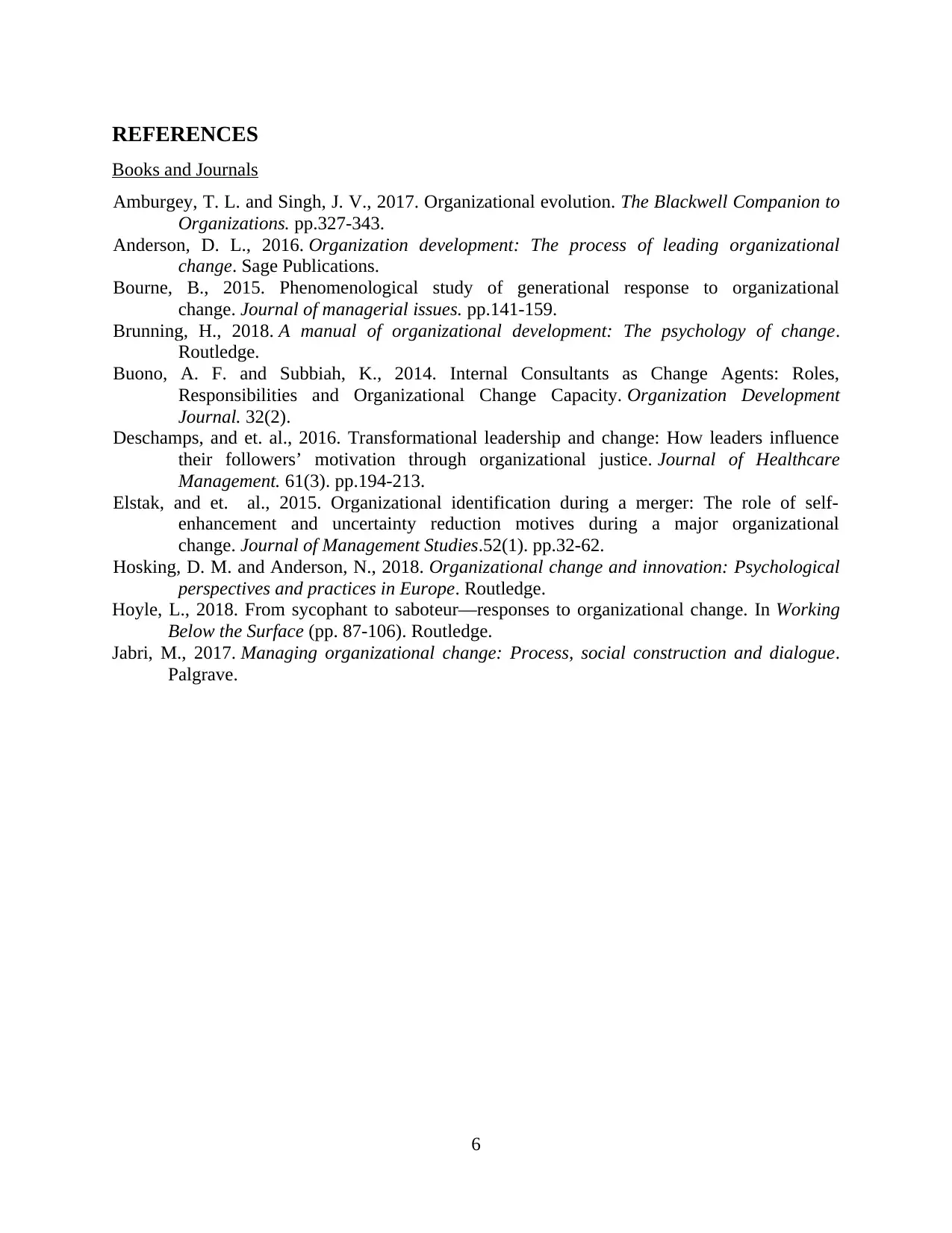
REFERENCES
Books and Journals
Amburgey, T. L. and Singh, J. V., 2017. Organizational evolution. The Blackwell Companion to
Organizations. pp.327-343.
Anderson, D. L., 2016. Organization development: The process of leading organizational
change. Sage Publications.
Bourne, B., 2015. Phenomenological study of generational response to organizational
change. Journal of managerial issues. pp.141-159.
Brunning, H., 2018. A manual of organizational development: The psychology of change.
Routledge.
Buono, A. F. and Subbiah, K., 2014. Internal Consultants as Change Agents: Roles,
Responsibilities and Organizational Change Capacity. Organization Development
Journal. 32(2).
Deschamps, and et. al., 2016. Transformational leadership and change: How leaders influence
their followers’ motivation through organizational justice. Journal of Healthcare
Management. 61(3). pp.194-213.
Elstak, and et. al., 2015. Organizational identification during a merger: The role of self‐
enhancement and uncertainty reduction motives during a major organizational
change. Journal of Management Studies.52(1). pp.32-62.
Hosking, D. M. and Anderson, N., 2018. Organizational change and innovation: Psychological
perspectives and practices in Europe. Routledge.
Hoyle, L., 2018. From sycophant to saboteur—responses to organizational change. In Working
Below the Surface (pp. 87-106). Routledge.
Jabri, M., 2017. Managing organizational change: Process, social construction and dialogue.
Palgrave.
6
Books and Journals
Amburgey, T. L. and Singh, J. V., 2017. Organizational evolution. The Blackwell Companion to
Organizations. pp.327-343.
Anderson, D. L., 2016. Organization development: The process of leading organizational
change. Sage Publications.
Bourne, B., 2015. Phenomenological study of generational response to organizational
change. Journal of managerial issues. pp.141-159.
Brunning, H., 2018. A manual of organizational development: The psychology of change.
Routledge.
Buono, A. F. and Subbiah, K., 2014. Internal Consultants as Change Agents: Roles,
Responsibilities and Organizational Change Capacity. Organization Development
Journal. 32(2).
Deschamps, and et. al., 2016. Transformational leadership and change: How leaders influence
their followers’ motivation through organizational justice. Journal of Healthcare
Management. 61(3). pp.194-213.
Elstak, and et. al., 2015. Organizational identification during a merger: The role of self‐
enhancement and uncertainty reduction motives during a major organizational
change. Journal of Management Studies.52(1). pp.32-62.
Hosking, D. M. and Anderson, N., 2018. Organizational change and innovation: Psychological
perspectives and practices in Europe. Routledge.
Hoyle, L., 2018. From sycophant to saboteur—responses to organizational change. In Working
Below the Surface (pp. 87-106). Routledge.
Jabri, M., 2017. Managing organizational change: Process, social construction and dialogue.
Palgrave.
6
1 out of 8
Related Documents
Your All-in-One AI-Powered Toolkit for Academic Success.
+13062052269
info@desklib.com
Available 24*7 on WhatsApp / Email
![[object Object]](/_next/static/media/star-bottom.7253800d.svg)
Unlock your academic potential
Copyright © 2020–2025 A2Z Services. All Rights Reserved. Developed and managed by ZUCOL.





